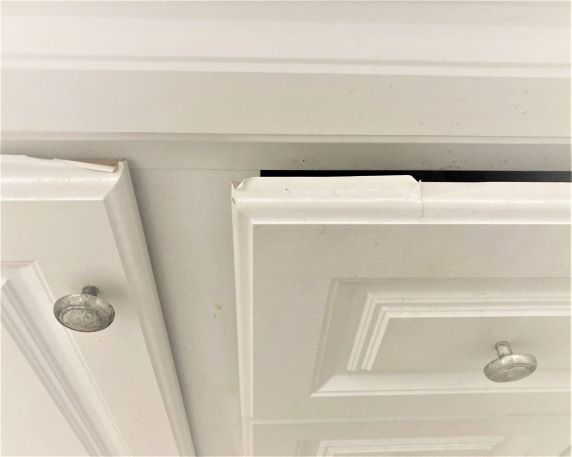Thermofoil Cabinets – Fixing Cracked Plastic Finishes with a Sprayed Painted Finish
There is a wide array of building materials, design choices and finishes that are used on modern cabinets in new homes. Among them, thermofoil cabinets has been an option for many years as a cost-effective process for finishing cabinet doors. Thermofoil is essentially a PVC vinyl wrapping that is heat and vacuum sealed over the front and sides of the wood. Most thermofoil cabinets today use MDF doors that are detailed and profiled by a CNC machine. The plastic coating is heat sealed over the full profile of the door, sealing in all the edges and details in one uniform coating.
Because the process leaves the back of the door uncovered, most producers finish the backside with a simple sheet of white melamine. What you end up with is a durable synthetic coating with a sheen similar to a sprayed lacquer finish. .
Thermofoil wrapping is not a service that we offer at Distinctively Paint. However, we do often help clients fix issues with peeling vinyl by stripping and replacing the coating with a colour matched sprayed finish. For this article, we will explore a bit more about the benefits of thermofoil, some of the issues that develop with it, and our process of replacing old thermofoil with a sprayed lacquer finish.
Properties of Thermofoil Cabinets
One of the main selling points of thermofoil cabinetry is the physical durability of the product. Heat-shrinking the vinyl wrap on the top and around each side surrounds the exposed surfaces of a cabinet door. This protects it from the everyday actions of a kitchen space. The uniform surface coating leaves a bit to be desired in terms of detail. The vinyl wrapping will smoothen any defined edges or small detail areas. Painted cabinetry, on the other hand, accentuates defined edges and detail. Most of the other benefits however exist in the cost of the product. Thermofoil cabinets are generally regarded as an entry level kitchen.
Many in the industry will also argue that thermofoil has superior short-term durability, being more resistant to dents and chipping. The long-term durability however, the discolouration and potential peeling, is where sprayed lacquer takes the crown.
Long-term Issues with Thermofoil
One of the biggest concerns for thermofoil in a kitchen is potential exposure to heat and steam. Heat and steam can cause the vinyl to delaminate from the surface of the wood and begin to peel. Any location in the kitchen that may routinely get hot or humid, be it a dishwasher, stove, or countertop appliance such as coffee makers, toasters or kettles, is at risk of peeling and blistering.
This is one of the main long-term maintenance complaints about thermofoil on kitchen surfaces. We have been hired by numerous clients who have thermofoil peeling issues on their doors. In one extreme case, a ruined door because of an unfortunately placed candle.
Because of thermofoil’s vulnerability to heat and steam, two things commonplace to everyday use of a kitchen, even thermofoil providers will attest to the longevity of other, more resistant cabinet surfaces. Even small issues like a scratch or dent, or a small peeling area leaves you little option other than replacing the whole door. The short term durability may be a benefit but when something does go wrong, you’re left with little options in terms of a cost-effective fix.
Replacing Thermofoil with a Sprayed Coating
We have worked with a number of clients over the years who have had older, discoloured or peeling thermofoil doors and asked us to refinish them in sprayed lacquer. It is a fairly straightforward process to do. And one that often leaves the doors looking better than they ever have.
The process for replacing the vinyl wrap is as follows: Once the thermofoil begins to delaminate, our recommendation is to completely strip the piece to the original wood base using scrapers and directed heat. Either a heat gun or a blow dryer will do the trick, and as the directed heat slowly builds up the thermofoil wrapping bubbles and peels away. A colour and sheen match would have been made in lacquer, at which point we follow our standard procedure for sanding, filling and refinishing any door or section of the cabinets. If you’re dealing with old and discoloured or peeling thermofoil on your cabinet doors, whether it is one or all of them, contact Distinctively Paint to learn about the benefits of replacing old vinyl wrapping by painting the cabinets with a fresh new vibrant coat of sprayed lacquer.

